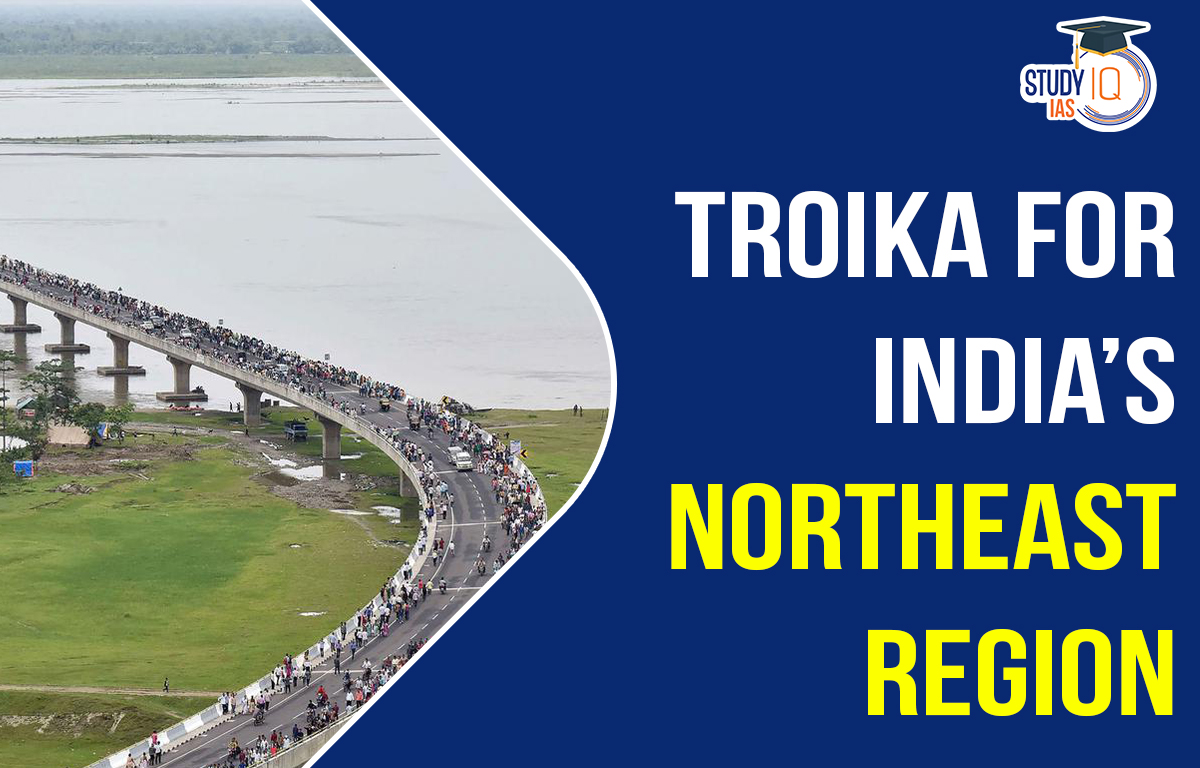Table of Contents
Context: At a conclave on connectivity and regional partnership between Northeast India, Bay of Bengal region, Bangladesh and Japan, representatives of both Bangladesh and Japan recently said that Tripura faces a huge potential of international connectivity to become a trade and commerce gateway in the region.
The North East Region of India
- States: The Northeast region of India comprises eight states – Assam, Arunachal Pradesh, Manipur, Meghalaya, Mizoram, Nagaland, Sikkim and Tripura – each with its own distinct history and identity.
- International Boundaries: The region shares its borders with Bhutan, China, Myanmar and Bangladesh.
- India’s Act East Policy: It is a diplomatic initiative by India to promote economic cooperation, cultural ties and develop strategic relationship with countries in the Asia-Pacific region through continuous engagement at bilateral, regional and multilateral levels thereby providing enhanced connectivity to the States of North Eastern Region with other countries in our neighbourhood.
- The Northeast of India has been a priority in India’s Act East Policy.
- This eastward drive started in 1992 under the Look East policy.
Importance of India’s North East Region
- Natural Resources: The North-East is a vibrant source of energy, oil, natural gas and limestone. Its geo-strategic location and natural resources also makes it a potential powerhouse of India for development and progress.
- Biodiversity: Northeast of India is home to both unique flora and fauna. It is one of the biodiverse regions of the world.
- Trade and Tourism: The region has huge potential for export of a variety of agro products and remarkable local handicrafts and performing arts can act as a magnet for promotion of international tourism for neighboring the Western countries as well.
- Economic Groupings: The Northeast is located at the hub of a geographical space which is home to the population of Bangladesh, Myanmar, Nepal, Bhutan, Southwestern China and the Association of South East Asian Nations (ASEAN).
- Regional groupings such as Bay of Bengal Initiative for Multi-Sectoral Technology and Economic Cooperation (BIMSTEC) and the ASEAN can all act as catalysts for promoting wide-ranging economic cooperation for both bilateral and multilateral trade and commerce.
- Strategic Importance: Northeast India has an extraordinarily important international strategic dimension and is a vital part of the nation’s defence architecture. It is not only India’s land bridge to Myanmar but also a gateway to Southeast Asia and beyond.
- The Siliguri corridor is a region that shares a border with Bhutan, Nepal, Bangladesh and China with an area of just over 100 km in India’s control.
- The roadways and railways near the Line of Actual Control (LAC) are connected by the Siliguri corridor.
- The Siliguri corridor is a region that shares a border with Bhutan, Nepal, Bangladesh and China with an area of just over 100 km in India’s control.
Projects in North East India
- Matarbari Deep Sea Port: The Matarbari Deep Sea Port (DSP) is being developed at the southeastern coast of Bangladesh with Japanese assistance.
- It the holds potential to become a regional hub for industrial value chain connecting Northeast India through Tripura with Bangladesh and onward onto the larger Bay of Bengal region.
- Maitri Setu: The inauguration of Maitri Setu over the Feni River was one of those landmark projects between Tripura and Bangladesh. Tripura will emerge as the gateway to Southeast Asia.
- Agartala–Akhaura Railway Link: It will connect Gangasagar in Bangladesh to Nischintapur in India and then to Agartala railway station in India.
- This rail link will reduce the journey time between Agartala and Kolkata by passing through Dhaka instead of Guwahati.
- Kaladan Multi Modal Transit Transport Project: It has been jointly identified by the India and Myanmar to create a multi-modal mode of transport for shipment of cargo.
- It will connect Sittwe Port in Myanmar to the India-Myanmar border and contribute to the economic development of the North-Eastern States of India.
- It also provides a strategic link to the North-East, thereby reducing pressure on the Siliguri Corridor.
- Eastern Grid: India is planning to develop “Eastern Grid,” a 5,000km-long waterway to boost connectivity and trade between eastern Indian states and BBIN (Bangladesh, Bhutan, India and Nepal) nations and amplify trade potential with Southeast Asian nations as well.
- The Eastern Grid can further amplify trade with countries like Myanmar, Thailand, Malaysia and Singapore.
- India-Myanmar-Thailand Trilateral Highway: India is pushing for the early completion and expansion of the India-Myanmar-Thailand Trilateral Highway to improve connectivity in the region. The connectivity to Cambodia, Laos, and Vietnam is also seen as a counter to China’s Belt and Road Initiative.
- Meghalaya Integrated Transport Project (MITP): In 2020, the World Bank-funded Meghalaya Integrated Transport Project was initiated to “improve and modernize the transport sector and help Meghalaya to harness its vast growth potential for high-value agriculture and tourism”. The initiative includes 13 projects amounting to Rs 547 crore including the construction of three major bridges.
Challenges in the North East Region
- Physical Connectivity: Difficult and hilly terrain, geographical location and short working season pose a challenge to development of optimal infrastructure and communication links within the region and with the rest of the country.
- Infrastructural Bottlenecks: The infrastructural bottlenecks include inadequate road and railway connectivity, power transmission and distribution, telecom connectivity and absence of airports in the region.
- Digital Connectivity: The objectives of improving mobile connectivity in all the villages in the region, improving high-speed internet connectivity, last mile internet connectivity from the village to a consumer have not been achieved satisfactorily.
- Trade and Commerce: The industrial scenario is not encouraging in terms of the number of factories as well as the shares of fixed capital, invested capital, net value-added and the number of workers in the industrial sector as compared to the all-India position.
- Population and Education: While there are number of colleges and universities, North East Region lags behind in quality education and lack of constructive higher educational institutions.
- Natural Resources Utilization: Northeast India is a storehouse of natural resources which are essential for creating employment and generation of GDP in Northeast India are either underutilized, unutilized, and mismanaged.
- External Security: All eight states of the North-East have international borders with China, Myanmar, Bangladesh, Myanmar or Bhutan.
- With such vast borders, there is always room for illegal immigration, arms smuggling, cattle and commodity smuggling.
- Internal Security: The North-Eastern states have witnessed a rise of insurgent activities and regional secessionist movements. Some of the insurgent groups are United ULFA, PLA, NSCN, ATTF.
- Territorial Conflicts: There are existing inter-state and international territorial conflicts within the Northeast that are often based on historical border disputes and differing ethnic, tribal or cultural affinities. Example: Assam-Mizoram Border Dispute.
Way Forward
- Roads and ports must be accompanied by job opportunities that can come only from new industrial enterprises set up with national and foreign investment.
- China’s aggressive actions in the region can be countered by India and Japan and other like-minded countries who can cooperate in the wider expanse of the Indo-Pacific
- Japan views Bangladesh and other areas to the south as a single economic zone and it will seek to promote the Bay of Bengal-Northeast India industrial value chain concept in cooperation with India and Bangladesh to foster the growth of the entire region.
- Japan as a single investor in the northeast is unworkable. Indian companies too must invest. India must ease restrictions on the flow of investments from Bangladesh.
- The goal of connecting a large part of South Asia with Southeast Asia can come from the triad of Bangladesh, India and Japan (BIJ). A BIJ Forum should be launched first at the level of Foreign Ministers, a move that will be welcome in the northeast.


 TALASH Initiative: Objective, Key Featur...
TALASH Initiative: Objective, Key Featur...
 Custodial Deaths in India, Types, Issues...
Custodial Deaths in India, Types, Issues...
 MPPSC FSO Recruitment Notification 2025 ...
MPPSC FSO Recruitment Notification 2025 ...





















